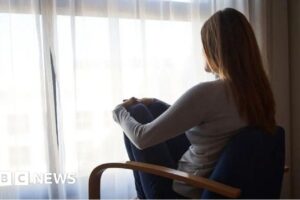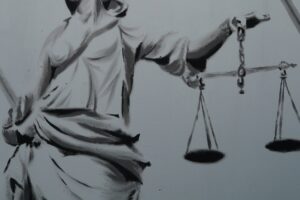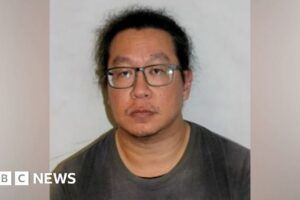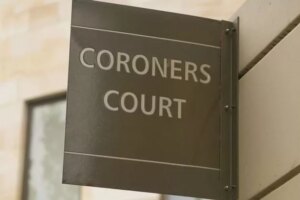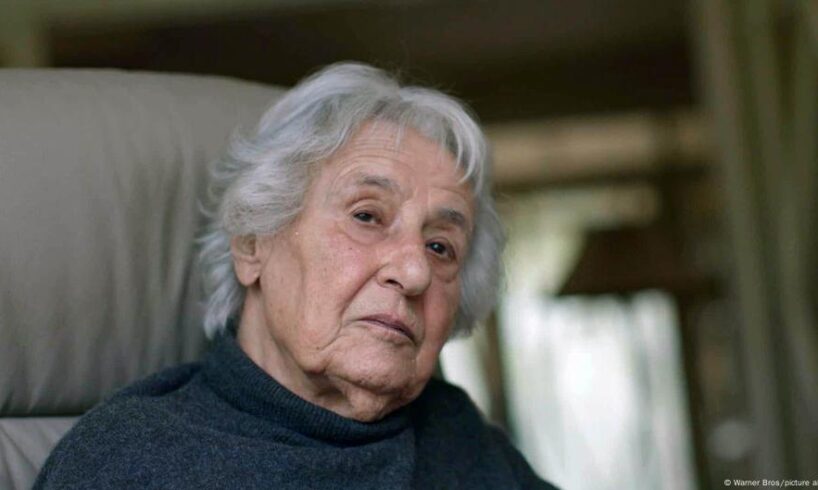
Anita Lasker-Wallfisch has spent an entire century on this earth, and does not fear death. After all, she’d often looked it in the eye when she was deported to Auschwitz simply for being a Jew. It was the largest and most notorious of the Nazi concentration and extermination camps. There, around around 1.1 million people were killed on an industrial scale.
Lasker-Wallfisch survived because she could play the cello.
While at Auschwitz, Anita Lasker-Wallfisch spent every day expecting to be killedImage: Frank Schumann/zb/picture alliance
For decades, she has raised her voice against antisemitism, right-wing extremism and racism as a dedicated witness to history. She has told scores of schoolchildren unsparingly how the Nazis systematically marginalized Jews and ultimately murdered them. She feels it is a duty “that those who survived must serve as voices for the millions who were silenced.” That’s why she has also taken part in the “Dimensions in Testimony” project, in which interactive holograms enable Holocaust survivors to answer questions even after their deaths.
There was a time when Lasker-Wallfisch was optimistic that her commitment was having an impact. “I’ve spoken with thousands of schoolchildren. If just 10 of them would behave properly, I’d be satisfied,” she said.
Recordings for the contemporary witness programmeImage: obs/Stiftung EVT/USC Shoa Foundation/Z. Lightfoot
Never heard of the Holocaust?
But in the meantime, Lasker-Wallfisch has become overwhelmed by hopelessness. “She’s in despair,” her daughter, Maya, told the weekly newspaper Jüdische Allgemeine Zeitung. Growing antisemitism, an increasing shift towards the extreme right and the situation in the Middle East all give Maya’s mother the impression that all her commitment hasn’t amounted to much.
Considering the current global situation, her despondency is understandable. It’s not only because 12% of Germans aged 18 to 29 have never heard of the Holocaust, according to a recent Jewish Claims Conference survey. It’s also because since Israel’s war in Gaza, antisemitism has been spreading worldwide.
“Is it important whether you’re Jewish? You’re simply a human being,” she recently told German daily Süddeutsche Zeitung.
‘I didn’t know I was Jewish’
Born Anita Lasker on July 17, 1925 in Breslau, she was the youngest of three sisters in a middle-class family. Her father was a lawyer and her mother a violinist. Her parents valued a good education and music was part of that. The Laskers were not at all religious.
“I didn’t know I was Jewish until they spat at me and called me a ‘dirty Jew’,” she said decades later. “We were ordinary, fully assimilated Germans.” That was in 1933, the year the Nazis seized power. Her parents had no illusions about what the Nazi regime planned to do with the Jews. At the end of 1939, they brought Anita’s eldest sister, Marianne, to safety in England. But they were unable to save themselves. After they were deported in 1942, she never saw her mother or father again.
Anita and her sister Renate Lasker-Harpprecht (left, † 2021) received the Jewish Museum Berlin Prize for Understanding and Tolerance in 2016Image: picture-alliance/Eventpress HHH
Lasker-Wallfisch and her sister, Renate, had to work as forced laborers at a paper factory. She used this opportunity to forge documents for other forced laborers from France, enabling them to return to their homeland. In 1943, when the two sisters tried to flee with forged passports, they were imprisoned. Five months later, they arrived separately at Auschwitz.
The ‘Cellist of Auschwitz’
Because Lasker-Wallfisch could play an instrument, she was assigned to the girls’ orchestra at Auschwitz. “The cello saved my life,” she later said. When the forced laborers left the camp in the morning and returned in the evening, the orchestra played music for them to march to. On Sundays, the girls performed for the SS.
Music under the swastika
To view this video please enable JavaScript, and consider upgrading to a web browser that supports HTML5 video
“Not a single one of us believed we’d make it out of Auschwitz in any other way than up the chimney,” were her words. In 1944, when Soviet troops were advancing on Auschwitz, Lasker-Wallfisch and her sister were moved to the extremely overcrowded concentration camp at Bergen-Belsen, where people died of hunger, thirst and disease. “Auschwitz was a camp that systematically murdered people,” she later wrote in her memoirs, “in Belsen, you just died.”
‘We’re full of hope and new courage’
British soldiers liberated the camp on April 15, 1945. One day later, the BBC’s German-language program broadcast one of the first eyewitness reports of German concentration camps. Lasker-Wallfisch came up to the microphone: “The Auschwitz prisoners, the few that remain, all fear the world will not believe what happened there,” she said.
She then described the horror in detail: “Liberation finally came on the 15th. The liberation we’d been hoping for for three years. We still think we’re dreaming. We see the English driving through the camp, people who want to do us no harm … But now we’re looking forward. We’re full of hope and new courage. We’re liberated.”
Under the supervision of the British liberators, guards load unburied victims onto lorriesImage: dpa/picture alliance
A long silence about the past
In September 1945, she testified against people who had run or worked at Bergen-Belsen before a British military court. It would be a long time until Lasker felt able once again to speak of her experience.
She emigrated to Britain in 1946. In London, she became a founding member of the English Chamber Orchestra and played in this ensemble until the turn of the century. She married pianist Peter Wallfisch, who, like her, was from Breslau. He had emigrated to Palestine as part of the Kindertransport (German for “children’s transport”) — an organized rescue effort of mainly Jewish children from Nazi-controlled territory. The couple did not speak to their children about the past. When her daughter, Maya, asked her mother why she had a phone number tattooed on her arm, she responded “I’ll tell you when you’re older.”
After many decades, Lasker-Wallfisch was ready to tell her story. Her book “Inherit the Truth 1939-1945: The Documented Experiences of a Survivor of Auschwitz and Belsen” was published in 1996. It made her internationally known as a witness to history.
In 2018, on the German Day of Remembrance for the Victims of National Socialism, Lasker-Wallfisch gave a fiery speech in the country’s parliament, the Bundestag, admonishing people not to forget. She said she perceived an increasing societal sentiment to leave such things in the past. Lasker-Wallfisch continued, “What are we meant to draw the line under? What happened, happened, and it cannot be expunged by drawing a line.”
Holocaust survivor Anita Lasker-Wallfisch addresses the Bundestag
To view this video please enable JavaScript, and consider upgrading to a web browser that supports HTML5 video
Now Lasker-Wallfisch is turning 100. A concert is being held in her honor in London. Dignitaries from all over the world are coming to congratulate one of the last living witnesses of the Holocaust. Her daughter Maya, son Raphael, grandchildren and great-grandchildren will also toast her. But what’s important to the centenarian isn’t the extravagant celebration. What Lasker-Wallfisch desires above all is that the poison of hate and antisemitism be eradicated once and for all. A wish that is, unfortunately, not so easy to fulfill.
This article was originally written in German.
